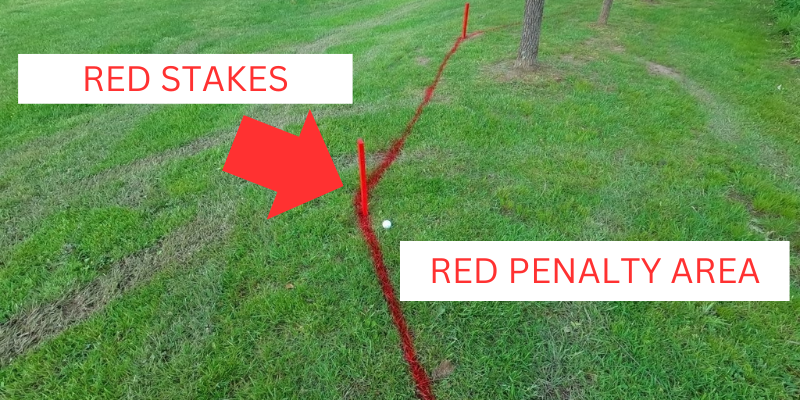Knowing the rules for red stakes in golf is essential, where precision and rule adherence matter.
The presence of red stakes on the course signifies more than just a splash of color against the green backdrop; these markers come with a set of rules that every golfer must understand to navigate the fairways successfully.
In this guide, we explain the importance of red stakes in golf, outline the associated rules, and offer a straightforward roadmap for golf enthusiasts to play the game correctly.
Understanding the Basics
Before getting into the details of red stake rules, let’s first understand the basic purpose of red stakes on the golf course.

Red stakes primarily indicate a hazard, an area where the ball may be lost or face interference from environmental features.
Hazards, often featuring water bodies or environmentally sensitive areas, present challenges that require a golfer’s skill and strategic thinking.
The most common application of red stakes is to mark lateral water hazards.
These hazards include lakes, ponds, and streams where the water’s edge is defined by the presence of the red stakes.
Moreover, red stakes can signal various hazards, including environmentally sensitive areas where preserving the natural habitat is essential.
Rules for Red Stakes

Identifying a Hazard: The first and fundamental rule is to identify when a hazard comes into play. If your ball comes to rest within an area marked by red stakes, you are in a hazard.
This applies whether your ball is in the hazard itself or if any part of your ball touches the hazard.
Options for Play: Once you’ve established that your ball is in a hazard, understanding your options for play is important.
Unlike other parts of the course, you are not allowed to ground your club in a hazard before making a stroke. You have three primary options when your ball lies within a hazard:
- Play the ball as it lies, accepting the challenge of the hazard.
- Play a ball outside the hazard, keeping the point where your original ball last crossed the hazard’s margin directly between the hole and the spot on which the ball is dropped.
- Take a penalty drop behind the hazard, keeping the point where your ball last crossed the hazard’s margin in line with the flagstick.
One-Stroke Penalty: The decision to play the ball within the hazard or take a penalty drop comes with consequences. In both cases, a one-stroke penalty is incurred.
This underscores the significance of making strategic decisions based on the particular circumstances of your ball’s location in relation to the hazard.
Navigating Lateral Hazards: When dealing with lateral water hazards marked by red stakes, golfers have an additional option for relief.
In this scenario, you can drop a ball outside the hazard within two club lengths of and not nearer the hole than the point where the original ball last crossed the hazard’s margin.
Provisional Ball: If there is doubt about whether your ball is in the hazard, you have the option to play a provisional ball.

To learn more about strategic play and how the provisional ball can be a golfer’s best friend when facing the possibility of a lost ball, read our article about the lost ball rule.
This is a smart strategy, especially when the hazard is not immediately visible or when playing a ball into a potential hazard area. If the original ball is found outside the hazard, you can continue play without penalty.
Consulting the Rulebook: While a general understanding of the rules for red stakes is essential, golfers are encouraged to consult the official rulebook for comprehensive guidance.
Rule 17 of the Rules of Golf, titled “Penalty Areas,” provides in-depth information regarding hazards, including the use of golf red stakes and the corresponding rules for play.
Conclusion
Understanding the rules for red stakes in golf is essential, as they serve as a vital guide for players facing hazards and challenges on the course. Whether you’re a beginner or a pro, mastering these rules is key to confidently navigating the fairways.
Whether dealing with water hazards or environmentally sensitive areas, knowing the options and penalties tied to red stakes is essential.
As you step onto the course, let the red stakes not only mark challenges but symbolize a game played with skill, strategy, and strict adherence to the rules that define golf.
Are you new to golf or looking to brush up on the rules? Check out our guide on how to play golf.
🏌️♂️ What do red stakes mean in golf?
Red stakes in golf indicate penalty areas or areas with specific rules. They are crucial for players to navigate the course correctly.
🏌️♂️ How do red stakes affect play?
Red stakes denote penalty areas where golfers may incur penalties. The rules for playing from these areas differ, impacting strategy and shot selection.
🏌️♂️ Are there specific rules for red stakes in golf?
Yes ✅, golf rules for red stakes outline how players should proceed when their ball enters these designated areas. Understanding these rules is essential for a fair game.
🏌️♂️ Can I move a ball that lands in a red-staked area?
Depending on the specific situation, you may have options, but there are rules to follow. Consult the golf rules for red stakes to determine the correct procedure.
🏌️♂️ Are there penalties for hitting into a red-staked area?
Yes ✅, golfers may incur penalties for hitting into red-staked areas. Familiarizing yourself with the rules prevents unnecessary penalties.